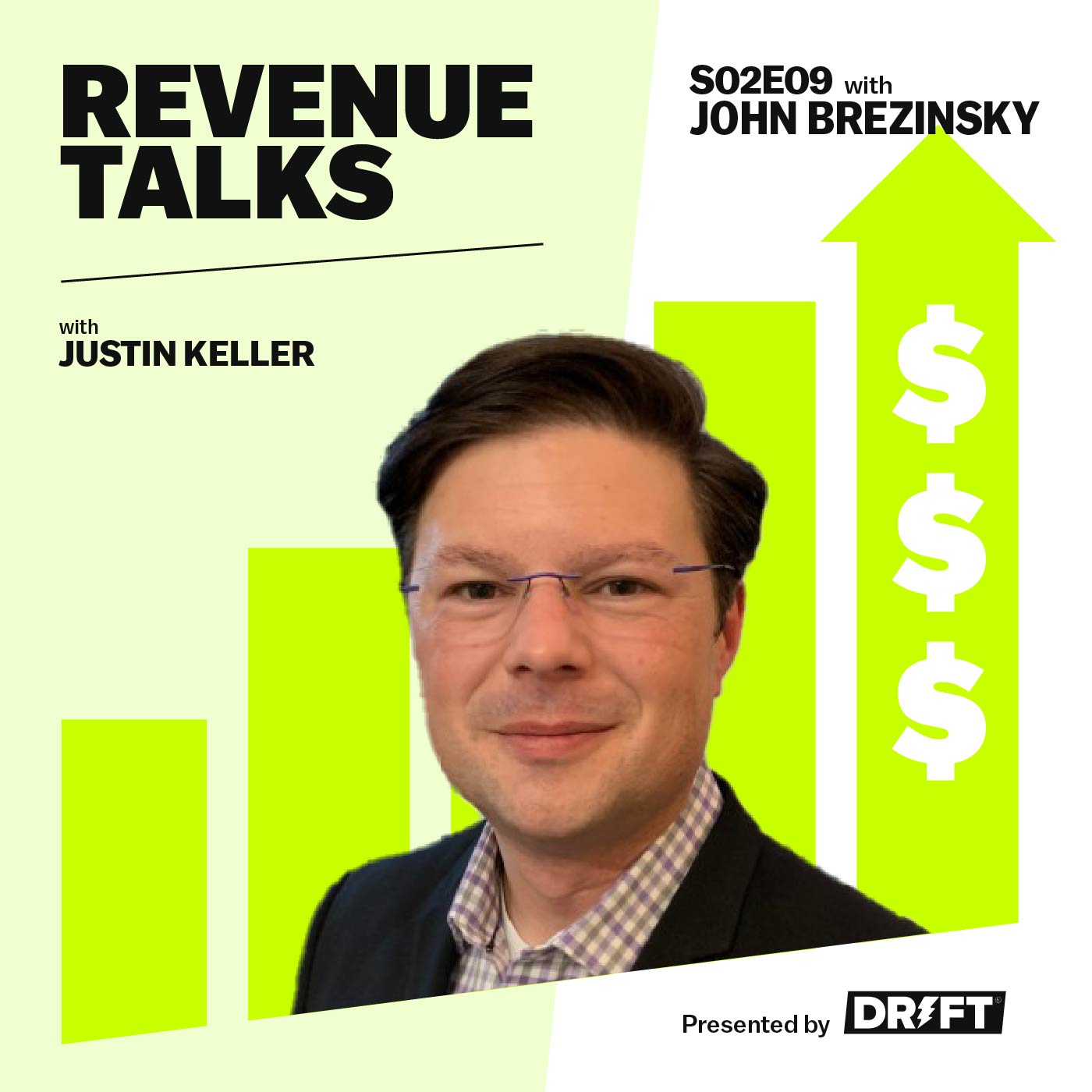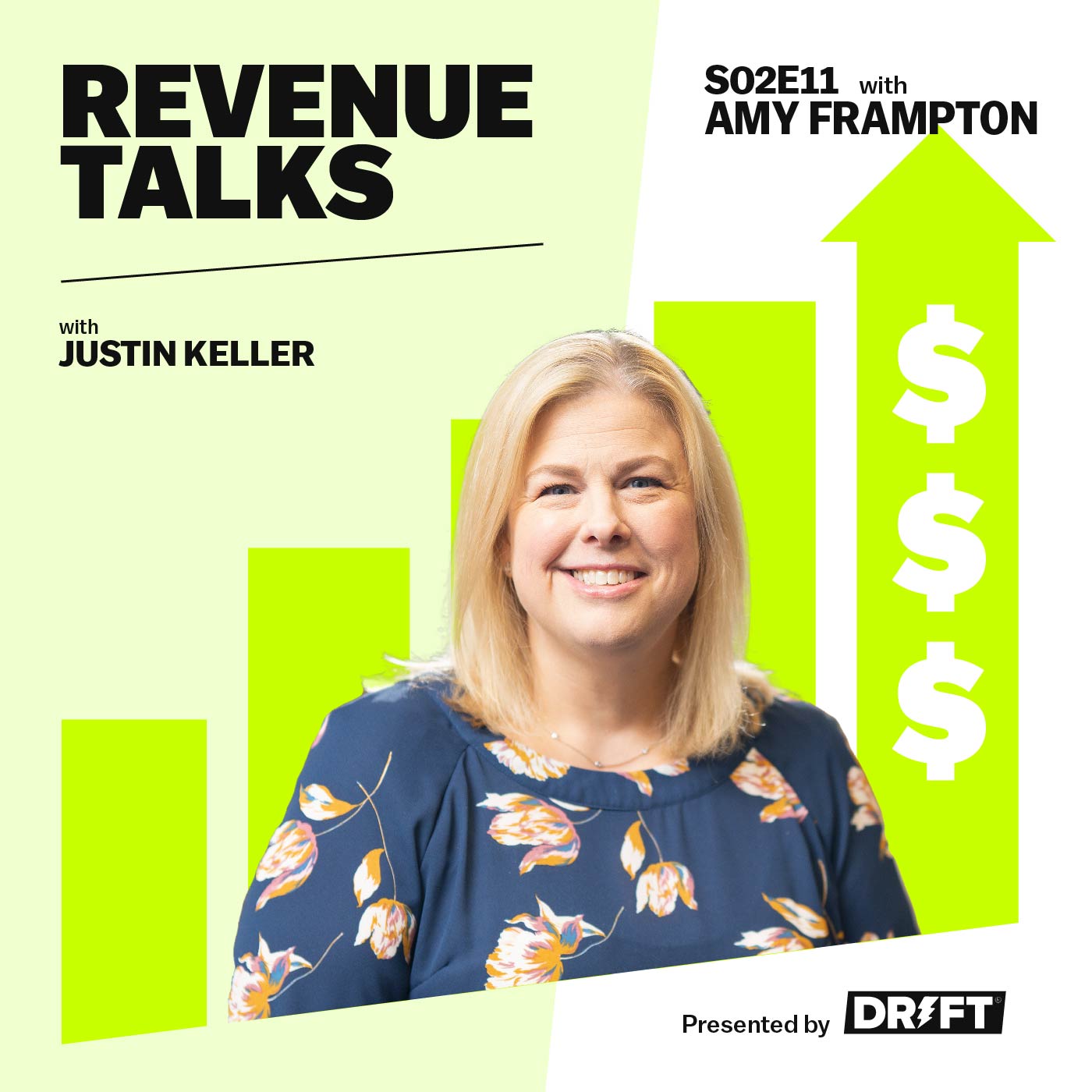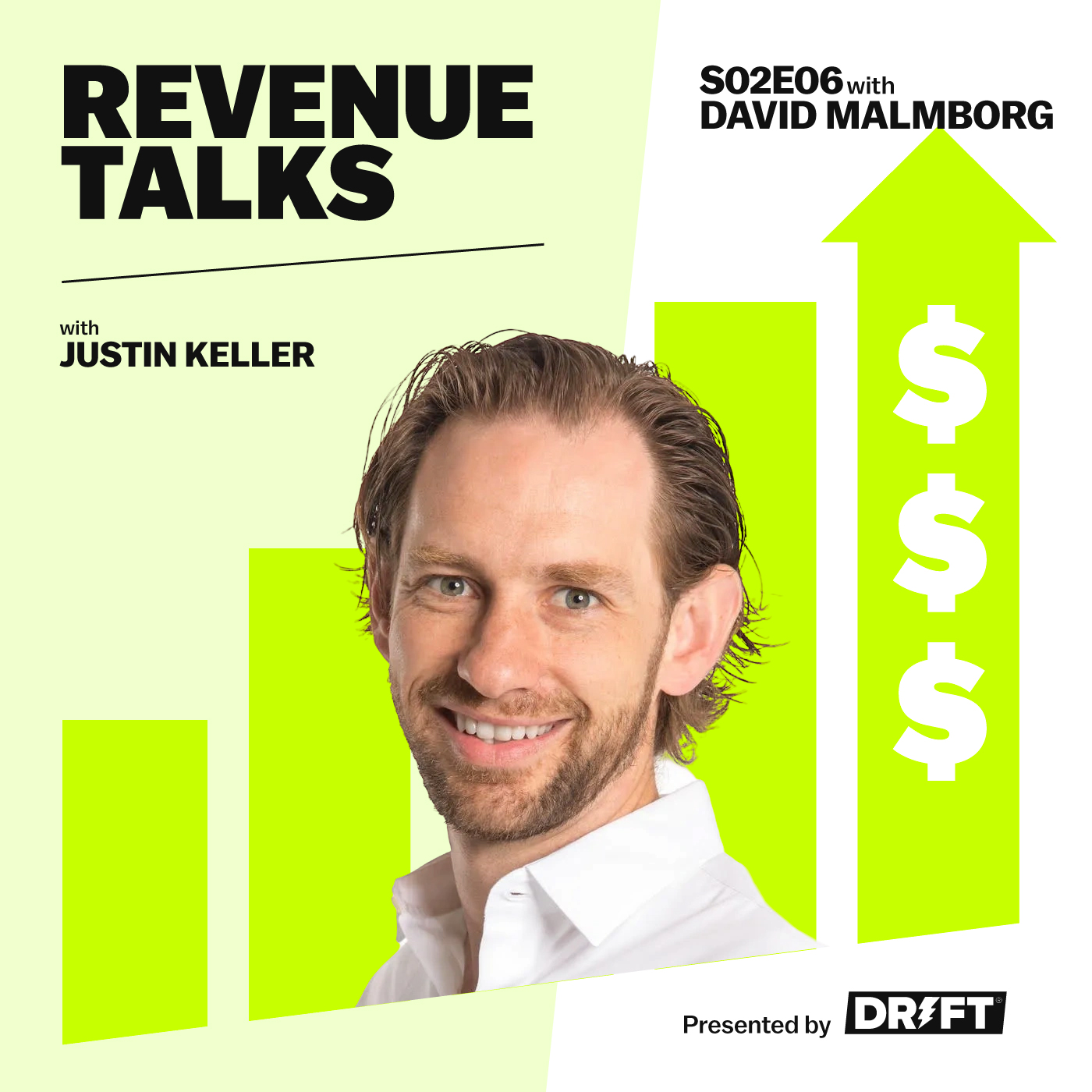How To Be The CIA of Marketing | John Brezinsky
- 0.5
- 1
- 1.25
- 1.5
- 1.75
- 2
Justin Keller: Welcome to Revenue Talks, the show where we get real about what it takes to build pipeline and drive expansion as a go- to- market team. I'm Justin Keller, the Vice President of Revenue Marketing at Drift. And on this show, I'm here talking to folks across the entire go- to- market organization, which means marketing, sales, and customer success, about how these conversations, technology, and cross- functional alignment to build more pipeline and drive expansion because revenue, it's everyone's business now. Hey, everybody. Justin here. Welcome back to Revenue Talks. John Brezinsky is joining me on the show today. John is the VP of Global Product Marketing at Searchmetrics, which is a global provider of search data, of software, and of consulting solutions. John's got many years building out product marketing programs at a variety of companies, both large, small, global, and regional. And we're going to share some of the biggest lessons he's learned from his experience. So let's get into it. John, thank you for joining me on the show. Before we get into all things product marketing, two things here I think that are both firsts on Revenue Talks. One, I think you're our first product marketer, so that's amazing. And you are definitely our first international guest, so congrats. You're coming to us from Berlin, correct?
John Brezinsky: That is correct, yeah.
Justin Keller: And how are you finding Berlin this time of year?
John Brezinsky: No, this is wonderful. And thanks very much for having me. I'm glad to represent the global community and absolutely glad to represent product marketing. But for those out there who have never been to Berlin, I absolutely recommend it. It's a beautiful city, very cosmopolitan, a great place to be.
Justin Keller: I absolutely co- sign that, Berlin is, I've had some wild adventures in Berlin, really, really beautiful city, really fun city, and really just so much to explore there. So I'm glad to hear that. You moved there for Searchmetrics, correct?
John Brezinsky: I did. I did, just this past April. Me, my wife, our daughter, and a pair of corgis we packed up and made the great journey across the Atlantic. And it's been a really good transition for me. It's a global team, but HQ is here in Berlin and it's filled with a lot of really smart people who care a lot about helping enterprise clients drive more revenue from organic search.
Justin Keller: Love it. And how's the adjustment been for the Corgis?
John Brezinsky: Actually, really good. Berlin is also a very dog- friendly city. The suburb of DC where we were before, there weren't that many dogs around. So they get a lot of interactions with a lot of different animals, and they tend to be pretty popular.
Justin Keller: That's good to know. Okay. Are they picking up any German, are you picking up German?
John Brezinsky: Yes. So for me, it's essential. I mean, if you're living in a place, it's certainly helpful if you speak the local language. The dogs understand some English, but typically ignore commands that they don't want to reply to in English, and they tend to do the same in German.
Justin Keller: Perfect. Okay. Good segue because one of the things I want to ask you about is in product marketing you're responsible for the messaging, how you're conveying the value of the product, and that means different things to different people. You may be conveying one thing to your Corgi, you may be conveying another thing to a global market. Both are received differently. So what has your approach been, or how have you found success in scaling message across global markets?
John Brezinsky: Okay, great question. The real answer is it depends, which maybe sounds a little bit like a cop out, but it isn't because it really does depend. The first and most important question, of course, and honestly the only thing that matters with developing messaging is what your target segments plural are going to respond to. So that's really the question, what do they care about? What's going to make a difference to them? So before you can even think about scaling any kind of message, you have to do the homework and put in the hard work to find out what's really going on with them. What are the pain points? What do they like about their jobs? What makes them happy? What makes them unhappy? And when you do that kind of homework, what you'll find is, in my experience at least, people honestly are more similar than they are dissimilar. The job really defines what people care about. But as you're doing the homework, you may find that certain parts of the world respond to different phrasings differently. Some parts of the world might prefer things that are a little bit more assertive or positively spun, whereas other parts of the world might regard that as being too over the top. So really it comes down to doing the homework and then identifying where and if there are significant differences. If there are, okay, well then, that drives the directions that you roll things out in.
Justin Keller: Yeah. Can you tell me about the homework though? What does that entail?
John Brezinsky: Yes. Okay.
Justin Keller: So maybe preface the question, how many markets are you in globally, and then what is the process of just segmenting those out and figuring out what resonates with what market?
John Brezinsky: Sure. So we serve primarily enterprise e- commerce corporations, which tend to have global footprints themselves, but whose global marketing teams and the teams that are running the websites tend to be based in wherever corporate HQ is. So for us, that tends to be Europe and it tends to be North America. So when we're talking about doing the homework, by which I just mean market research, for us, it tends to be mostly Europe and North America, mostly the US. But what we have are fairly well- defined job titles for the people who are either using the software or interacting with the consultants or analyzing the data and in many ways, more importantly, the people above them who are making the larger strategic decisions for the company. So once you know who you're going after, which of course, most of your listeners do have fairly well- defined ICPs and fairly well- defined job titles, what I'm talking about really is just developing the personas.
Justin Keller: Yeah.
John Brezinsky: And there are a number of techniques that people have used. My favorites are honestly some of the oldest ones in the books. I'm a big fan of surveys. I'm a big fan of interviews. But there's a lot of detail, of course, that goes into those.
Justin Keller: You've got surveys. You've got interviews. How do you go about indexing that? Do you have a spreadsheet somewhere on your computer where it's like, " Okay, in the German version of the website, we say this, in the Dutch version, we say that"? How do you organize all that? And then how do you measure that if at all?
John Brezinsky: Oh, good grief. Okay, so those are both huge questions. So let me start with the actual personas and defining the messages as they ought to be used. So yes, we do in fact have a repository that define starting with similarities, things that we believe to be globally the same for, say an executive who works in e- commerce or the leader of a search engine optimization team, or the CMO at an e- commerce company. Starting with the similarities for those job types and then breaking out where we see differences, which sometimes actually have more to do with the way that the company itself is organized than the part of the world that they're operating in. Give you a quick example. The SEO teams traditionally used to be part of the marketing organization. And so what that typically means then is they work very tightly with the rest of the marketing teams, with the digital marketers, with the content teams, et cetera, et cetera. But they may not work as closely with the people who actually run the e- commerce engine that the company is based around. One trend that we've seen at larger companies is actually moving SEO over to the e- commerce part of the organization itself. If the website is the store, then it makes sense for the people who are optimizing the website to work in the same team as people who work in the store. What does that mean? Well, predictably it means that they have great relationships with the devs and the engineers and the people who are working on the technical side of things. They tend to have tighter relationships with the people who are running the product lines. But since they're no longer in the marketing team, now all of a sudden there are issues with communications across over to the people who are running the rest of digital marketing, paid search, for example. And so yes, in fact we do have these documents, and then we work out what we believe to be primary differences between, really it comes down to, for us anyway, the larger differences between a European message versus a more US- based message. And then, of course, we absolutely test these. We test them in email, in ads, on the website itself, and most importantly with our sales teams where we discuss messaging and we discuss experiments with messaging all the time.
Justin Keller: Okay. John, this is the closest to a CIA agent, a marketer I've ever talked to has been. I feel like you are you're just out there collecting information on all these different populations, centralizing it, giving it to your agents, which is very cool. Do you ever feel like that? Do you ever feel like you should wear a trench coat and a hat pulled down?
John Brezinsky: No. Okay. So that's a fair question. But I mean, the really cool thing for me, for me, so what I find to be really personally, professionally rewarding is just really understanding your segments because anyone who's done interviews, you ask people what do you like about your job? What do you dislike about your job? And the answers you get tend to be pretty boring. It tends to be stuff that you already know, especially the things about what do you dislike about your job? But if you can get under their armor, if you can get through the kind of professional words that they give you during an interview, get past the stuff that they're saying because they think that's what you want to hear, that's when things get really interesting. And I love this stuff. And in particular, I like it working at this company right now because what we're doing is cool. People think about SEO, if they think about it at all, they think about it the way that it used to be 10 years ago when honestly a lot of it was just tricking the search engines into showing your page. But the reality is people are telling Google three and a half billion times a day what they want. They're asking questions, they're saying, " I'm interested in this product, in this color." And if you can collect that data globally and then analyze it down to the local level, what you're looking at is real- world demand data.
Justin Keller: Yeah.
John Brezinsky: And communicating this purest form of demand data out to the head of SEO, the head of digital marketing, the person who's actually making product decisions, the person who's running the online store who has to decide what are we going to be featuring this month or that month, and especially the CMO who, if the CMO is not currently in a country that's in a recession, they're in a country that's entering a recession, communicating that stuff in a way that really makes sense to them, I mean, that's genuinely, genuinely rewarding to me.
Justin Keller: That is very cool. And I'm so glad to hear that for you. For the people listening, can you give a little bit of market research 101. So when you talk about getting under their skin or getting past what they want you to hear, what are some of the techniques you use to normalize that and to get more revealing information out of them?
John Brezinsky: I'm going to work with a couple of assumptions here. One is that the person doing this research has some ideas of what these people are already like but that you have some really big questions. And this is maybe especially useful for any of your listeners who are targeting a market that's maybe going through some kind of transition, maybe especially given the current economic climate where we're coming out of the world of nonstop change in the pandemic years. It's still kind of pandemic years, but not really. But now we're looking at global recession. So things are in flux. I'm going to go back to my two favorite techniques of interviews and surveys. Also, just to kind of set the stage in case any of the listeners haven't done this in a while, quick reminder that interviews are good for going deep. Interviews are good for your qualitative information. Whereas the surveys, this is your quantitative, this is where you're going to get answers to hypotheses with statistical significance. Okay. So let's start out with the interviews. If you're building a messaging stack, you really need to understand just some basic things about a given persona. You need to understand what gives them satisfaction at their jobs. You need to understand what causes them pain at their jobs. And you also need a better understanding of how they interact with other people in the company, and in particular what their boss holds them accountable for. So you're going to ask them those questions. But here's the issue. Most people, when they're doing an interview, they're their affective filter is ramped way up. They don't know you. They don't feel particularly comfortable. They also want to look good despite the fact that you will have assured them that their name won't be used anywhere. It's still a professional environment. You want to look good. Okay. So a couple techniques. Always start with a warm- up. And the only goal for the warm- up is just to get them relaxed, to help lower that affective filter, make them feel like they're talking with a friend. And a great question for this is something along the lines of, " Hey, I saw your resume on LinkedIn. You've had an interesting career. Can you just tell me how you got to the job that you're at now?" I like this partly because it's easy, also partly because everyone likes talking about themselves. And once they kind of get going, you can usually see it in the body language. They'll start to sit a little bit lower. They'll start to feel a little bit more friendly with you. And that's when you can start moving into slightly deeper questions. You want to know what they like about the job, ask them. " Tell me what you like about your job?" And they'll tell you. The only thing is though, what they'll tell you at first is going to be relatively basic, high level, not particularly connected to emotions, the basic stuff. Let them do that. But then push them a little bit farther. And one of the easiest ways to do that is to just ask why. So they said they like this. So, " That's really interesting. Tell me more about that? What do you really like about that?" Now, the second answer that you get is still going to be relatively surface level. So just don't let it go. Keep digging. Depending on the person you're talking to, you can actually even ask them, " So when this happens, this thing that you've said that you like for this reason, how does that actually make you feel?" Once they get used to the idea that you're looking for more emotional, deeper things, and after the first time that they say it, they'll start to feel more comfortable. Then of course, you need to tell them, " All right, I've asked you what you like, then clearly I'm going to ask what you don't like." This one is honestly even harder. And I find this is especially harder for people based in the US where no one wants to suggest that they have problems at work. No one wants to suggest that there's something that they don't do very well or something they don't like doing. So keep asking why. And another thing that you can do is let them keep talking. And if they stop talking, inserting a pause there, inserting a pause, people get uncomfortable and they want to fill it.
Justin Keller: Yep.
John Brezinsky: Let them. Let them. Give them a little bit of silence, right?
Justin Keller: Yep.
John Brezinsky: Here's another one though. And I'm actually going to give this one verbatim, so we'll pretend that I'm interviewing you.
Justin Keller: Okay.
John Brezinsky: I say, " Okay, cool. Thanks for all that." So an expression that I've heard recently actually is called the Sunday Scaries. Have you heard of that?
Justin Keller: I have.
John Brezinsky: Yeah. Yeah, yeah. It's the, okay, so Sunday afternoon, people start to get a little bit anxious about what's coming the next Monday. Now, I'm not suggesting that anything at your job could actually cause you anxiety, but if it did, what would those things be? And what I like about that is first it sets it up in something a little bit lighthearted. And then it's also not saying that anything actually makes you anxious, but hypothetically speaking. One more. And I like saving this towards the end because it requires a little bit more analysis and it also requires the person to be really relaxed. One thing that I like to understand is the way that people interact with other job functions. So instead of just asking them, " So tell me about your relationship with this team, with that team," I actually ask them about stereotypes and start from the outset by just saying, " I don't want to hear about any specific person who you actually work with, but let's go down the list of the other functional groups that you interact with. And let's just talk about stereotypes. So those people in paid search, those people in social, those people in PR. Those people, what are they like?" And I find that people are taken a little bit off guard by the question and give you really honest answers. And by interviewing people from each of those different functional groups and asking them about the stereotypes that exist about all of the other functional groups, you end up getting this really cool 360 picture of how everyone functions or sometimes dysfunctions together.
Justin Keller: And so you look at that composite and you kind of say, " Okay, these five departments shared on the sixth department many different adjectives, but this one showed up in all six." And then that becomes almost a true stereotype. That's an identifiable trend that everyone thinks about them. Fascinating.
Elizabeth: Hey, it's Elizabeth, the Producer of the Drift Podcast Network. I hope you're enjoying this episode of Revenue Talks. If you're looking for even more go- to- market best practices, check out our e- book, GTM Lab. You'll get go- to- market hot takes and secrets from the industry's brightest minds on how to ignite every phase of your strategy, giving you even more ways to energize your marketing and sales efforts. Give it a read at drift. ly/ gtmbook. Now, back to the show.
John Brezinsky: And what I love is it almost doesn't matter what's really true. The only thing that matters is what is perceived to be true.
Justin Keller: Yes. Perception is reality. And that's one of those things that I think marketers get either hung up on or take too liberally and just get way, way hopped up on their own hype, which is interesting. Market research is not about finding cold- hard facts, it's about finding what the perception is and then messaging towards that.
John Brezinsky: Absolutely.
Justin Keller: Wow. John, that CIO thing, CIA thing rather was kind of a throwaway joke. I hope I don't blow your cover, but I think that you may actually be in the CIA. Living in Berlin, practicing interrogation techniques is all such cool stuff that I've not thought about or talked about before. This is fascinating. So, okay. You've got now a giant stack, a tome of market research that is relevant across a global set of marketplaces. We've talked a lot about how that may function online, but not where the rubber meets the road, where you're actually giving that to your field team, your sales force, what have you. What is that process like of dispersing or disseminating such a variety of... Information's kind of got a common nucleus, but then has all these different flavors surrounding it. How do you effectively get that out there, communicate it the right way, and make sure that that is then being communicated again the right way?
John Brezinsky: Yeah. So what I'm about to say is going to be really familiar to any of your listeners who are also in product marketing because the relationship between product marketing and the sales teams, whether it's for new business or renewal business, is one of the most important relationships and one of the easiest to get wrong that exists. So for starters, before we even talk about rolling it out, this firsthand market research that we're doing, we're also doing with the sales teams themselves. I mean, it's axiomatic that they are out there in market all the time. And if they're really good at their jobs, they're also experimenting with different ways of talking about things all the time. So you've absolutely got to collect information from the teams broadly. And this is using very similar techniques of both interviews and surveys so that everyone can contribute. And then what that means is when you've done the final analyses and you've agreed to these are the most important things, here's all of the additional detail and color, when you start rolling it out, you can be honest and say, " This isn't just my opinion. This was collected from all of you as well as surveys in which we had X hundred respondents as well as interviews with people, if you have these job titles at these types of companies. This is in fact nobody's individual opinion. This is the way that it is."
Justin Keller: Yep.
John Brezinsky: The actual logistics of getting the message out, I mean this is as varied as there are varied companies, but my general suggestion for anyone who needs to communicate with sales teams for anything, whether it's messaging or anything else, is more than one method is best.
Justin Keller: Yes.
John Brezinsky: If you can get it out during a meeting, great. Get it out during a meeting. You've got a dedicated Slack channel, push it through that dedicated Slack channel. You've got regular emails that you send to the sales teams, put it in the regular emails that you send to the sales teams. And then also bear in mind that people who are out there selling, they don't have, excuse me, they do have exactly the same amount of mental attention as everyone else in the world, which is to say we're all busy. And so if they forget about something that you told them two months ago, yeah it's because they've got other things on their mind.
Justin Keller: Yep.
John Brezinsky: They're thinking about this deal, they're thinking about the next deal. And a hugely important thing for product marketers to do is keep communicating, keep communicating, keep communicating. If someone forgets, not a problem, tell them again.
Justin Keller: Yeah. I've learned this as a hard and fast rule, there is no silver bullet to communicating to a sales team to enabling them. It is just consistency and volume. You cannot over communicate enough, which is frustrating to so many marketers I know. Like, " I sent that to you three times. It was in the Slack. Why didn't you go back and reference it?" Doesn't matter. You have to just keep that fire hose on full blast at all times.
John Brezinsky: Absolutely. And look, they need to keep in mind so many factors about this deal and that deal and the other deal. And I would prefer that they keep those things front of mind. If they forget where a case study is, I can find them that case study.
Justin Keller: Yes. Yes, no shade was meant for our friends in sales, right? They're busy. They're closing deals. Keep doing what you're doing. I think this is just a PSA for the marketers. Your job is, like it or not, in service of the sales team, and keeping that communication up is very, very critical. Now, what about how marketing comports into campaigns? Does the ball start rolling with you and then head over to your campaign or demand gen team based on the messaging frameworks that you've established, or how does that work with you guys?
John Brezinsky: Sure. So as with a lot of stuff, once we start talking about real campaigns, good grief, every company truly is different and everyone is in a different situation. And what it really comes down to is the overall company strategy. So I'll speak to a company strategy that is primarily focused on target accounts. It's primarily focused on outbound campaigns around those specific accounts. Start with the goals and in fact, what are the sales team's goals, globally, by region, down to the individual SDR and AE? What do they need to accomplish? And then based around those goals, and based then on the kinds of KPIs that marketing can be held responsible for to help meet those goals, go and talk to your leaders. Sometimes it might be best to start at the regional level. Sometimes you might start with a group of people who are down at the country level, but start with them. And my recommendation to marketers who are planning on campaigns is to not roll into a conversation with sales teams with your strategy or, heaven forbid, your tactics already fully worked out. It needs to be a conversation. You've probably already got some pretty good ideas, but still let it be a conversation because the more that you work with your sales teams, the more your sales teams will work with you. And ultimately that's the goal is for sales and marketing to be working together because at the end of the day, all that we're doing is driving more revenue for the company. So start with conversations. And then for each step along the way, whether it's goals or strategies or down to tactics, get sign off, get it in writing, so that way the next level of brainstorming or planning is just that much easier. I do also like to be able to have conversations with some of the better AEs, especially if there's a head of account executives. The same goes for SDRs. But ultimately, it needs to be sales leadership who buys in, signs off, and says, " Yes, we agree. This is the way that we, sales and marketing together is going to go after this set of target accounts."
Justin Keller: Yeah, yeah. I love that. It's a partnership at the outset, but then it's a contract at the end, right?
John Brezinsky: Absolutely.
Justin Keller: And that's no matter what it is, right? Account selection, messaging, who's going to do what, that's the way to do it. Gosh, John, this has been an education, sales and marketing alignment, market research...
John Brezinsky: Who knew?
Justin Keller: ... howto scale this out. Mind is blown. I've got one more question for you today, and this is the signature Revenue Talks question, and it is this, what's the one thing that you're doing this year to help accelerate revenue for your company?
John Brezinsky: Sure. So for us right now, it is moving towards a better framework for not marketing qualified leads, but marketing qualified accounts. So for us, this is really, it's exactly what we were just talking about. It's working together with sales to make sure that we're able to capture every interaction that every lead has with everything that we're doing, whether it's a phone call from an SDR or a webinar from marketing, that we're able to capture that and really turn that into actionable insights at the account level.
Justin Keller: I love it. All right. John Brezinsky, or should I say Agent Brezinsky, this has been an awesome conversation. Everybody, thank you so much for listening. John Brezinsky is the Global VP of Product Marketing at Searchmetrics. What an amazing conversation. Thank you so much for joining us. Literally, mind is blown. This has been awesome. I appreciate you.
John Brezinsky: Hey, thanks very much. It's been a pleasure.
Justin Keller: Thank you so much for listening to Revenue Talks. If you like this episode, please consider leaving a review wherever you're listening. You can connect with me on Twitter @ justinkeller and at the entire Drift Podcast Network at @ DriftPodcasts. Remember, revenue, it's everyone's business now.
DESCRIPTION
The CIA and product marketing: Two industries that are obviously different yet strikingly similar.
In this episode of Revenue Talks, Justin discovers why John Brezinsky (VP of Product Marketing at Searchmetrics) might have a background, or a future, as a CIA agent. John shares how his team figures out what messaging will resonate with different audiences across the globe, how to then ensure that the other go-to-market teams at Searchmetrics use that messaging, and how his product marketing organization fits within Searchmetrics' larger campaign strategy.
Talking Points:
- (00:00) Introduction
- (3:26) John’s approach to scaling product messaging across global markets
- (5:19) Do your homework: How John’s team figures out what messages resonate with what market
- (12:39) What John loves about his job
- (13:12) Market Research 101 with John
- (21:55) How product marketing disseminates their research and messaging to the broader go-to-market organization
- (25:53) How Searchmetric’s product marketing team fits within the company’s broader campaign strategy
- (28:56) The #1 thing John’s team is focused on to accelerate revenue for Searchmetrics this year
Like this episode? Leave a review!
Read more go-to-market best practices: https://drift.ly/GTMBook
See who Drift's other Marketers to Watch are: https://drift.ly/MarketerstoWatch








